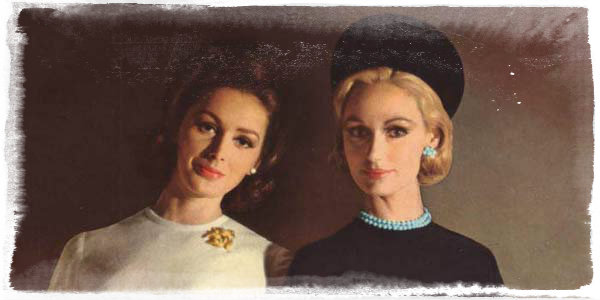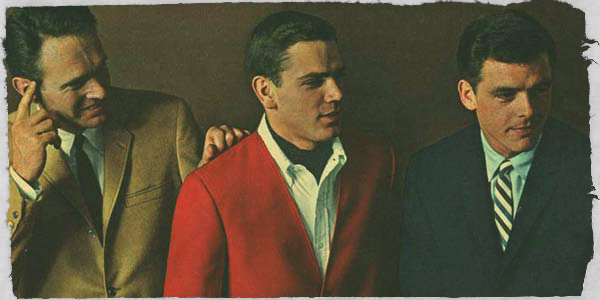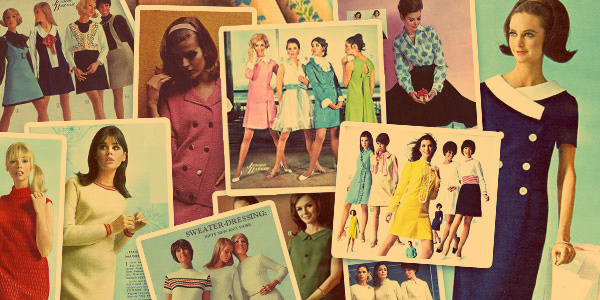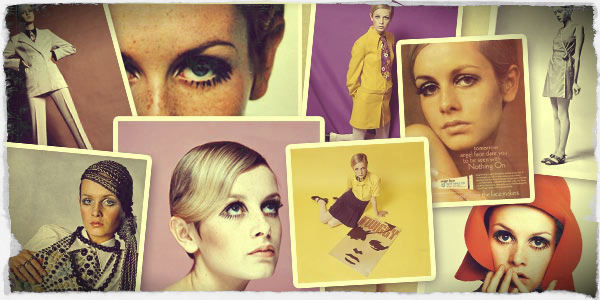
1960s fashion was bi-polar in just about every way. The early sixties were more reminiscent of the 1950s — conservative and restrained; certainly more classic in style and design.
It’s almost like the 1950s bottled everyone up so much that the late 1960s exploded like an old pressure cooker. Women were showing more skin than ever before.
For the first time in the 19th Century, London, not Paris, was the center of the fashion world. The British Invasion didn’t stop with The Beatles. It swept into all parts of life, especially clothing.
But actually, lost in the two extremes is the mid-60s, which I think actually had the coolest style, albeit more subtle. I love the long, slender shapes, the bright colors and the young, London look. I have always wished the Mod style stuck around a little longer.
Keep reading below for details, covering every year from 1960-1969.
1960s Fashion Timeline
1960 | 1961 | 1962 | 1963 | 1964 | 1965 | 1966 | 1967 | 1968 | 1969
1960s Fashion: In-Depth Profiles
1960s Fashion: Pictures
In-Depth 1960s Fashion Profiles
1960s Fashion: Women & Girls »
1960s Fashion: Men & Boys »
1960s Dresses & Skirts: Styles, Trends & Pictures »
Twiggy: Pictures, Bio & Model Profile »
Fashion in 1960
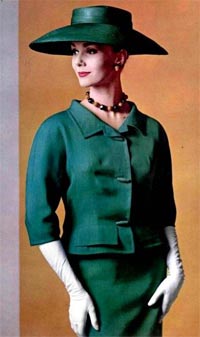
Givenchy suit (1960)
The typical daytime look consisted of a bulbous hat over a high bouffant coiffure, silhouettes with deep armholes an wide sleeves, and a rounded jacket that tapered in at the hem.For evening, the slender look was in. Long-waisted dresses, often with an overblouse, replaced the fitted waistline and full skirt.
Contemporary architecture and sculpture were the most prevalent inspirations for fashion designers in 1960. There were also hints of the twenties and thirties with bloused, bias-cut clothes, long straight overblouse and sashed tunics, short skirts, closely fitting hats and exaggerated makeup (especially red lips) and short hair.
Culottes, divided skirts and trim trouser skirts were introduced for travel, street wear and evenings at home. Bead and sequin embroidered evening clothes sparkled the night away. The long dress of sequins or crystal beads had replaced the bouffant dress.
Skirts got a little bit shorter in 1960. While worn with low-heeled shoes it placed more attention on the leg. Sleeveless daytime shirts placed more emphasis on the arms. Collarless coats, suits and dresses created a long-necked effect. Some dresses had draped cowl backs to intensify the elongated look.
The two- or three-piece suit, mix-and-match, was very popular.
Plaids of all sizes and colors were heavily favored. Abstract and expressionist art were big influences on printed silk designs. Wools were in style, but had to lightweight. Coat and suit woolens were usually loosely woven and sometimes as porous as lace.
Deep, darker colors were the rage in 1960. They especially covered the spectrum between purple, red and green. Colors like like grape, plum, wine red, garnet and olive green. In contrast, neon bright pink was also a very popular color for those looking to make a statement.
Furs and hats maintained their popularity, as did fur and seal coats. Evenings turbans of tulle swirled loosely around the head not only gained high fashion acceptance, but were sold in every hat shop.
Fashion in 1961
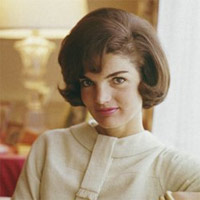
Jackie Kennedy (1961)
Oval shaped shoulders and tapered hemlines were being replaced by straighter, wider shoulders, accompanied by a gentle inward curve at the midriff and a flare at the hem.
Many designers created “the look” by designing not just the dresses, but also the hats, shoes and even makeup of their mannequins.
Skirts had risen to the middle of the kneecaps, but by the end of 1961 only the very young continued to wear them short.
The hairdresser was of extreme importance in 1961. Beehive coiffures adorned by the likes of Princess Margaret, Jacqueline Kennedy and Brigette Bardot were imitated by women of all ages.
The bias cut gave a new fit to clothing, while keeping the comfortable softness women had to come to love. The bias skirt added grace and flare, while bias bodices molded the torso without feeling too tight.
The “little nothing” dress was called so for its simplicity. It was almost always sleeveless and slim, with low blousing or in a loose chemise shape recalling the flapper dresses of the 1920s.
The high rounded hat and the low, square-toed shoe were the accessories of choice. The simple pump of calf, alligator, crepe or satin was worn morning and night, and the women of high fashion wore heels of medium height, even with ball gowns.
Fashion in 1962
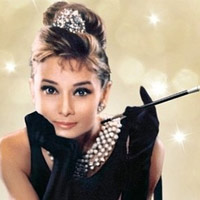
Audrey Hepburn helped popularize the high-bosomed, sleeveless dress in 1962
Shoulders were widened and the bosom received more attention. The waist was always accompanied by a belt, sash or wide inset bias band.
Costumes dominated evening wear, complete with matching jacket or wrap. Later in the season the long, tweed dinner coat was showcased in several high-fashion collections.
1962 mostly focused on 3 styles:
1.) Sleek and slender
2.) softly bloused with muffled neckline
3.) “natural” outline, which fell in a simple, form-fitting line
Greater choices allowed women to express their individuality.
1930s-style clothing came back in style, sparked by the rising popularity of old movies revived on television.
Clothes created by Hubert de Givenchy of Paris for Audrey Hepburn in Breakfast at Tiffany’s were given the lion’s share of credit for bringing into style the high-bosomed, sleeveless dress.
Irene Sharaff’s Egyptian costumes for Elizabeth Taylor in Cleopatra inspired dresses and jewelry.
A young designer by the name of Yves Saint Laurent, who had recently left the House of Dior, successfully opened his own establishment.
The fashion world once again was crazy for Jackie Kennedy. Her gentle, high-bosomed coats and dresses, slender evening dresses, berets, breton hats, her impeccable jewelry and even her sports wear consistently dominated fashion headlines.
Fashion in 1963
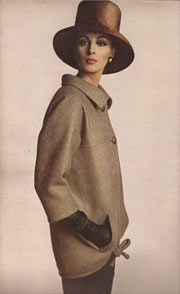
Although first shown in 1962, Saint Laurent’s fisherman’s shirt jacket was most popular in 1963.
Any type of artificial look was abandoned quickly. Large amounts of makeup and high heels were too contrived for the fashionable woman of 1963.
Tweeds, mohair, leather and furs were the rage. Boots ranged from ankle to thigh-high.
Vests, kerchiefs, textured cotton stockings, turtlenecks and paisley ascot scarves all came together to create a “sportive look.” The phrase became the motto of 1963 fashion.
Fur-trimmed suits and coats were the most prevalent items in fall fashions. Two preferred furs were lynx and kit fox — long haired furs were back in style. Leopard, however, was the leading fur of all of them.
The most drastic change in men’s fashion in 1963 was the widespread acceptance of pleatless pants. Stripes were seen on sports jackets, sweaters, shirts and ties. The three-button suit was the most popular, but the two-button suit was gaining fast. Men of means liked a soft Italian-style shoe.
Norman Norell and Cristobal Balenciaga were responsible for the reappearance of capes, while Yves Saint Laurent’s fisherman shirtjackets became world-wide fashion. In 1963, we get to see the first Geoffrey Beene collection.
Fashion in 1964
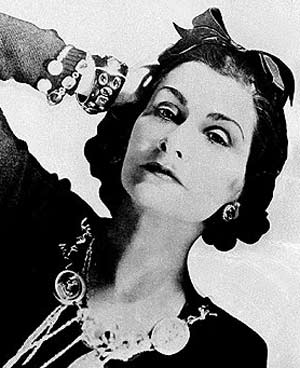
Coco Chanel wearing a hair bow
Dress manufacturers quickly jumped on the bandwagon, creating sheer-topped evening dresses with only the flimsiest layer of flesh-colored net used for a bodice.
The topless bathing suit created all kinds of problems. A woman in Chicago was arrested for wearing it in public. Throughout the summer, comments concerning the controversial design were published around the globe.
“Feminine” was perhaps the most overworked word in 1964’s fashion vernacular. It referred to swinging, knee-high skirts, fitted bodices, ruffles, pleats, a lace revival and the return of the hair bow as the coiffure accessory for women of all ages. “Coco” Chanel was responsible for the hair bow revival.
The cosmetics industry reflected the fragile, feminine look that had come into fashion. Pale lipsticks and nail polish replaced the vivid shades for the sought after natural look. Hair was no longer curly, but merely waved to follow the contour of the head. Eyebrow brushing bangs became the trademark of the young, along with hair bows work front, rear and off-center. Girls with hair too curly besieged hairdressers known for the straightening techniques — a chemical session that cost somewhere in the neighborhood of $40.
Textured stockings were very popular in 1964. Winter also saw the revival of fuller skirts, smaller coiffed heads under close-fitting hats and the return of the ball gown.
For men, the accent was on youthful appearance. Suit colors were lighter and brighter. Suit coats and sport jackets were shorter, with wider lapels. Trousers were often uncuffed. A wider stripe appeared on shirts and striped were popular in sweaters.
Fashion in 1965
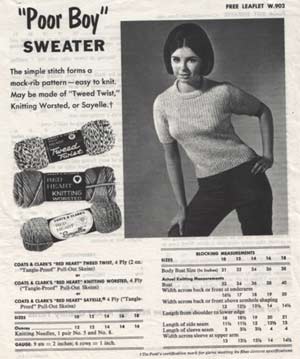
Vintage Poor Boy Sweater Ad
A fashion revolution broke out in London, and for the the first time a British fashion invasion stormed NYC.
In the US, Pop Art popped into style. Then along came Op Art, which opened up a whole new world. Women dressed to match Op Art paintings, with their stripes, checks and wavy line prints. Dressed were divided geometrically by intersecting bands and brightened by contrasting blocks of color.
The Mondrian style was a hit.
Rounded toed shoes became more prominent. Straps were evident, heels were open, sides were pared down to add to the look of leggy young elegance. Heels continued in the low to medium height range.
We cant forget about the “Poor Boy Look.” Women continued to wear low hipster pants in combination with the “poor boy” sweater (see picture).
Another fad caught on in the dressing gown space. Cristobal Balenciaga designed a gown with one bare shoulder and it caught on like crazy. Even Jackie O got into the mix.
The Saint Laurent Mondrian dress was a huge hit in 1965.
Fashion in 1966
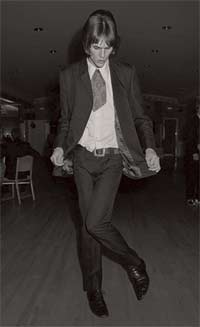
1966 Mod style
What is mod style?
The mod look required mini skirts and pale colored fishnet or lacy textured hosiery, cut-out low heeled “little girl” shoes, mannish jackets, and ties. Accessories included over-the-shoulder handbags and gaudy jewelry, which ranged from antique pins (like Bakelite pins) to modern styled geometric earrings.
Young men also went Mod via low slung, wide belted, skinny, fitted pants, to which they added extra-wide, flashy printed ties that contrasted with the wallpaper floral prints of their shirts.
Boots, vests, London caps and narrow Carnaby jackets were also worn by the young men who took part in the rebellion against traditional men’s clothes and conservative ways.
American youth became infatuated with the exotic, off-beat image, using it as a means of differentiating themselves from the adult generation.
Miniskirts were adopted to more conservative styles with the length modified to two inches above the knee. The new short-skirt fashion resulted in mixed emotions everywhere.
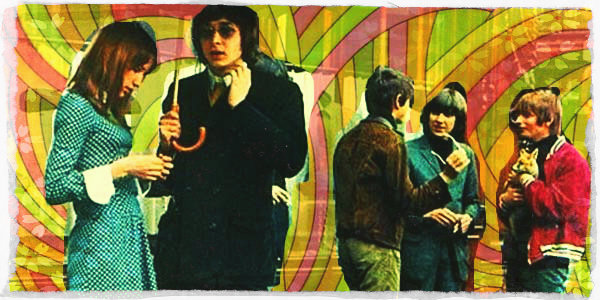 Women borrowed suit styles from men. They wore straight legged pant suits, often of what was traditionally men’s fabrics, for daywear.
Women borrowed suit styles from men. They wore straight legged pant suits, often of what was traditionally men’s fabrics, for daywear.
Pant suits were an acceptable means of fashion and were worn everywhere.
The military look was also popular. Army pockets, brass buttons, epaulets, and trench coat treatments were featured on coats, suits and sportswear.
Paper dresses were introduced in 1966 by designers such as Judy Brewer.
Fashion in 1967
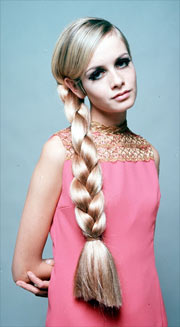
1967 Fashion: Twiggy was a fashion sensation
Women also wore peekaboo fishnets, spidery weaves and lace. Not only did they provide smoothness from hip-to-toe, but they also eliminated the possibility of garter show.
Women also fancied high boots as a fashionable way to cover up their legs. High-rise stretch vinyl and patent leather provided a glove-like fit. They also wore shiny black and brown boots that stretched to the knees.
Youth continued to set the pace for fashion. The belt did not define the waist anymore, instead it created a new “fit and flare” attitude.
In addition to leg, the fashion world fell in love with Twiggy, the skinny 17-year-old British model who burst upon the scene, adorned every magazine cover and brought the age of the mini-mod to the forefront.
Her success was controversial at the time. To some, she was an insult to the female figure, while other lavished her fresh, new look. Her slightly androgynous look blurred the lines between genders.
Another interesting development in 1968: hardware. Accessories consisting of metal squares, nailheads, rattling chains, zippers, brass buttons, clamps were something new. The chain belt was another important accessory.
In men’s fashion, the mood departed somewhat from the mod of Carnaby Street, but the British look was still evident. Turtleneck sweaters were an important trend, eliminating the need for a tie. The more daring sported a turtleneck under dinner jackets for a casual elegance.
Fashion in 1968
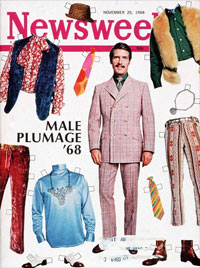
1968 Fashion: Newsweek cover: Male Plumage ’68
The catch phrase “do your own thing” was put into practice when women and men decided they no longer had to adhere to what designers put in front of them. People were creating their own styles to match their personalities and mood.
Accessories dominated the outfit, often times overpowering the clothes in importance. The new attitude was a reaction to the mini-dress of recent years, whose lack of fabric alone gave women less fashion real estate to work with.
Western-type shirts were very popular with the younger crowd. Women would tuck them into Dirndl skirts for a fun look.
The midi skirt was the fashion world’s answer to the long skirt that women wore against the designers’ wishes. Unfortunately for the fashion world, the midi skirt never caught on. It ended up being one of the biggest misses in recent fashion history.
The Bonnie and Clyde movie triggered nostalgia for the 1930s. Pinstriped suits and gangster hats were popping up here and there, looking like they walked right off a period movie set.
The most colorful, loud and expressive trends evolved from the outfits scavenged from thrift stores by hippies. Even affluent women adopted the hippie look in lavish fabrics, furs and jewels. It was a nomadic mix of ethnic and legend-inspired garb. Gaucho pants, meditation shirts and, especially, vests.
Some fashion trailblazers wore Pocahontas dresses complete with Native American headbands.
Paris finally had to accept what had happened. Designers could no longer pay the bills designing for the affluent. Saint Laurent led the way with his ready-to-wear collection. Balenciaga shocked the fashion world with his retirement in May.
Pants, celebrated for their versatility, were getting wider legs and softer. Women loved topping them with a color, ethnic-inspired tunic.
Male fashions in 1968 reflected the growing tendency to mix and match a wide variety of materials, styles and accessories. It was an exciting time in men’s fashion.
Tailored suits gave way to a unprecedented array of daring styles. Men wore turtlenecks, Nehru jackets and jeweled pendants. Even bright madras plaids were challenged by the flower-splashed resort blazers and P.J. (Lilly Pulitzer) jeans.
Fashion in 1969
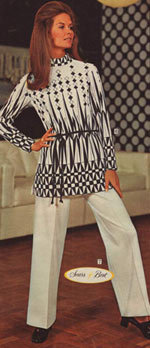 In 1969, fashion stretched, softened and became even more body conscious. A woman wanted to look lean, linear and long.
In 1969, fashion stretched, softened and became even more body conscious. A woman wanted to look lean, linear and long.
The sometimes funny, frequently edgy and nearly always mini-skirted girl of recent years grew up. Her fashion image became more feminine, sensuous and sophisticated.
She wore softer, clingier clothes. Sweaters and sweater dresses now hugged every part of her figure, particularly around the ribs, waist and hips.
Above all, she had freedom to chose from an unprecedented variety of hemlines.
Instead of choosing a hemline, designers gave women the choice. Both in Paris and in the United States, couturiers showed maxi-lengths, but were aware of sales enough to keep some styles short. Yves Saint Laurent made waves with his “lowdowns”, while skirts at Courreges barely covered the torso.
No matter the hemline, outfits were often topped with a jacket or long coat.
The long, lean line was the most obvious fashion trend in 1969. “The Skinny Sixties” closed appropriately as women looked for clothes that would give them a tall, slim body. Elongation was accomplished by extended skirts, long, straight-cut pants or, if she had long legs herself, they were accentuated by sheer dark tights.
Slender tunics, skinny long sleeves, low-rise pockets and belts, hip-hiding weskits and body-length cardigans helped fight a top-heavy look. The more fringe the better.
People also loved to wear super-scarves. Oblong in shape, some were 10 feet long, called Isadora Duncans. Long, fringe adorned shawls mimicked pearls. Feather boas, red fox stoles, and mink tails extended the silhouette by descending below the hemline.
Accessories flourished in fantasy, especially with young people. They couldn’t afford diamonds, so they enjoyed linked metals, chainbelts, tassels, snake rings, snake bracelets and arm bracelets.
In addition to new fabrics that did nothing to hide the figure, designers splashed color all over them. Tie dye and ink-splatter had broken into the mainstream.
Patchwork, Persian and Navajo rug motifs were seen everywhere. Intense primary colors turned subtle in the fall. Purple was a hot color in late 1969.
Because women were becoming more traditionally masculine (wearing pants) and men were becoming more traditionally feminine (wearing bronzing gels and moisturizers), the term “unisex” was coined for fashion styles that both men and women could enjoy equally.







